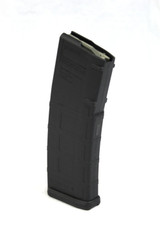
.308 VS 5.56: A CALIBER COMPARISON
Few cartridge showdowns are bigger than the comparison between the cruiserweight .308 Winchester (aka the 7.62x51 NATO) and the scrappy bantamweight 5.56x45 NATO. Both have a strong military pedigree, both are combat proven, and both have legions of loyal fans. Though often viewed through a lens of “which is better?” these cartridges have served alongside each other in different roles for several decades now. Let’s take a closer look at these rounds and see where they came from and what, if any is better about one versus the other.
A Brief History of .308
The .308 Winchester (we’ll just call it the .308 from here on out) was designed in 1952. Just a few years prior the US and the Allies had won WWII. The US’s battle rifle, the M1 Garand had served admirably (and would serve admirably in Korea, as well) but a replacement was being sought. Not only was a replacement rifle being sought, but so was a replacement cartridge. This cartridge would also become the standard battle rifle round of the North Atlantic Treaty Organization (NATO), hence the cartridge’s designation.
A newer NATO cartridge would be smaller. Smaller equaled lighter weight, the ability of the soldier to carry more ammo, and a smaller, lighter delivery platform. The result was the .308 Winchester, essentially a shortened .30-06 Springfield. Three early military rifles were designed around the .308: the US’s M14 from Springfield, the FAL designed by Fabrique National in Belgium, and the G3 from Germany’s Heckler and Koch.
All three of these rifles would serve in their respective military’s hands for decades to come and all would develop loyal and devoted followings. The “battle rifle” concept didn’t last long, however. The US Army ditched the battle rifle in Vietnam due to its weight and unwieldy length. The M14 has the ignoble distinction of being the last main battle rifle issued by the United States, as well as being one of the shortest-lived general issue rifles in US inventory.
The .308 didn’t go away, however. Instead, it was chambered in the machine gun that replaced the .30-06 caliber machine guns of WWII: the M60. The M60 general-purpose machine gun (GPMG) would become iconic in its own right. It was eventually replaced with FN’s M240 machine gun, also in .308, and various sniper rifles in US inventory are chambered in .308, as well, including the M110. The .308 wasn’t confined to military applications; indeed, it has been incredibly popular on the civilian market since its inception..
A Brief History of 5.56
The .223 Remington came along in 1962, a decade after the birth of the .308 Winchester. The little cartridge was designed as a deliberate project for a high-velocity, lightweight bullet for military use. It would eventually be chambered in Eugene Stoner’s brainchild, the M16 and the civilian version, the AR15, that we all enjoy today.
As we have seen, the .308 and its platform, the M14 were less than ideally suited for the jungles of Vietnam. A number of factors played a role in its replacement including size and weight, and the fact that the M14s wooden furniture would swell in the jungle heat and moisture causing erratic zero shifts. These factors, doubtlessly combined with others, led the US to adopt the M16 and its very lightweight 5.56 cartridge for general issue.
The .223 Remington was improved and by the early 1980s was designated the 5.56x45mm NATO, a high-pressure version that was not backward compatible with .223 chambers. Though the adoption of a small-caliber combat rifle was somewhat controversial at the time and in the post-Vietnam years, we now know that the 5.56 is quite the capable combat chambering. It – and its parent platform, the AR – have proven themselves reliable and lethal.
The 5.56 has expanded far beyond the AR15. It is also the chambering of the M249 Squad Automatic Weapon (SAW) and a host of other light machine guns. It can be had in bolt action rifles, as well. The 5.56 is probably the most popular rifle cartridge on the civilian market today.

AR15 5.56 Complete Uppers by SOTA Arms
308 vs 5.56 - Let’s look at the differences between these two cartridges.
Cartridge Specs: First, the .308 is a much larger cartridge than the 5.56. The .308 has an overall length of 2.80 inches, while the 5.56 has an overall length of 2.26 inches. This means that the .308 requires a longer action (and hence, a larger and heavier gun) to function. The bullet diameter of the .308 is, well, .308 inches. This is quite a bit larger than the .224-inch bullet of the 5.56. Typical bullet weights for the .308 are 150, 165 and 180 grains, while the 5.56 fires much lighter bullets in typical weights of 55-, 62, and 77 grains. Combined with a heavier bullet the .308 is the clear winner in terms of sheer power.
Recoil: This power comes at a cost. Recoil is night and day between these two rounds. While neither is punishing, the .308 generates much more recoil than the 5.56. This can be problematic in some circumstances, like full-auto fire. As the military learned, full auto fire of a .308 battle rifle is a losing proposition. This also comes into play in close quarters where fast target transitions are very important.
Velocity & Energy: The muzzle velocities of the two cartridges is different, but not as much as one might expect. Fired from a 24” barrel, a 150-grain .308 bullet is expected to achieve a velocity of around 2,800 feet per second. This generates a very impressive 2,600 ft-lbs of muzzle energy. Compare that to the lightweight 5.56. Fired from a 20-inch barrel, a 62-grain bullet should reach approximately 3,100 feet per second, generating only half the muzzle energy of the .308 at around 1,300 ft-lbs. That’s a pretty big difference and the .308 has a clear advantage in terms of energy.
Trajectory: How does that translate to bullet trajectory, though? Let’s take a look at the two cartridges’ performance at distance. Again, using a 150-grain .308 bullet fired at a muzzle velocity of 2,800 feet per second, bullet drop at 500 yards is just a hair over 54”. Let’s compare that with the same 62-grain 5.56 bullet fired at 3,100 feet per second from the muzzle. It has a bullet drop just a shade under 47 inches at 500 yards. This does give the 5.56 a slightly flatter trajectory but at such distance its energy is fading fast, while the .308 still has power to spare, it a longer effective range.
Sectional Density: Sectional density is the combination of a bullet’s surface area and its weight. Combined these two factors predict how well a bullet will penetrate on a target; the higher the number the more the bullet is expected to penetrate. This gives us some indicator of a bullet’s terminal performance. The 150-grain .308 is a larger bullet with more surface area, but with much more weight behind it than the 5.56. The sectional density of the .308 is .226 while the 62-grain 5.56’s sectional density is only 0.177.
Practical Applications
Both the .308 and the 5.56 are very popular rifle cartridges for civilian, law enforcement, and military use. Both have a broad set of applications. Let’s take a look at possible uses for both of the chamberings.
With full metal jacket bullets both are marginal performers on game but with modern, expanding soft points, both are amply capable hunting rounds. The .308 is preferred for large game, longer distances, and can take just about anything on the North American Continent. The 5.56 is capable of taking game up with whitetail deer, as well as smaller game like varmints. Both are also great choices for self-defense and law enforcement applications. The 5.56 is preferred in close quarters due to less recoil, while the bigger .308 is the go-to for greater distances.
.308 and 5.56 Upgrades from SOTA Arms
Both the .308 and 5.56 are right at home in semi-automatic rifles. The biggest difference – the size of the cartridge, bullet, and gun that fires it – should guide your decision in which to choose. Once you’ve decided, SOTA Arms has what you need to start, and finish, your next AR build.
.308 ARs: If you want an AR in .308 you will have to invest in a new lower receiver, as well. The longer cartridge requires a longer magazine well, and this platform is known as the AR10. SOTA Arms offers complete lowers, stripped lowers, an 80% lower, and all the parts you need to assemble a lower receiver. We also offer complete AR10 upper receiver assemblies in 18-inch and 20-inch barrel lengths, as well as a host of other AR10 parts like bolt carrierbolt carrier groups and magazines.
5.56 ARs: Of course, we also offer a broad selection of AR15 rifles chambered in the venerable 5.56 cartridge. Our “Guns of Color” line offers an extensive selection of complete rifles, and mated, stripped upper and lower receivers for those interested in a DIY build. We also have all the upper receiver parts you need including bolt carrier groups, gas blocks, handguards, and the upper receivers themselves.








